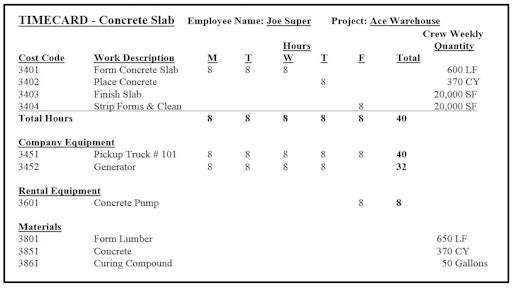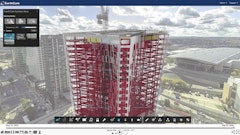
The main purpose of construction field crew time cards is to keep track of employee hours so you can pay them properly for the hours they work. Right? Not entirely true. If you also want to know and track accurate job costs, your time card can become an important business tool to make you more money. To make this happen, you need to design your time card to reflect how you do business and match what you want to keep track of.
Designed properly, your time card can become an invaluable tool to track labor production, field quantities installed, company and rental equipment usage, and materials consumed on the job. And then after gathering the information available from daily and weekly time cards, you can create a production tracking system to give your field foremen and superintendents updated job cost data so they will know how well they’re doing every week on their projects. To design an integrated time card to work for you, get your estimator, project manager and foreman together to determine which work task cost codes you want to keep track of.
When you bid a job, the estimator calculates exact quantities of work for each part of your scope of work. For example, to bid a new concrete slab warehouse floor, the estimator ‘takes-off’ the amount of labor, material and equipment to form the slab edge, place concrete material, finish the slab, and then strip the forms and cleanup. Each of these operations requires a bid estimate of crew production hours required to perform each task. Your time card cost code categories therefore must match how you estimate and bid in order to keep track and know actual hours required to do different parts of the job.
By observing the example time card (see figure 1), notice how the work is broken down exactly as the estimator bid the job. By having the codes match the time card, he can then calculate the number of hours required to perform each task after project completion to see if his production rates are accurate and match how he prices future projects.
When team leaders know what they are trying to accomplish, it makes it a lot easier to hit their targets. In order to give your foremen something to shoot for, they must know the quantities they are trying to hit and get a weekly update of how well they are doing. Before the job starts, the estimator should get together with the project manager and foreman to review the bid and quantities allocated to perform the entire job. The foreman then will have a budget to aim at. To keep track of how well the crew is doing versus the job estimate and budget, make sure your foreman records the quantities installed every week as noted on the time card. This way the foreman and project manager can review the progress weekly to see if they are staying on budget.
Estimators also calculate the number of equipment hours required to build projects. The time card can also be used efficiently to track company equipment and rental equipment usage. Set up your time card to include a listing of all of your equipment. Have the foreman record which equipment is used on the daily time card. Your accounting manager can then job charge your equipment weekly to the correct jobs based on where it was used. At the end of the job, you can then review the estimate of equipment versus the actual hours spent on the projects. Your foreman and project manager can also monitor the budget versus actual for equipment if given an update every week of these numbers.
You can also design your time card to track the materials used weekly on the jobsite. Have the foreman record what materials were installed or delivered to the job as shown in figure 2.
At the end of each weekly pay period, add up the number of hours spent in each cost code work item and compare it to the job budget. Review these numbers with your field foreman Monday morning to make sure they know where they are and what they have to do to keep their job on budget. Your estimator is the best person to prepare this weekly recap as he clearly understands the cost codes and job budgets. Plus, he will be the first to discover if his estimate is correct or there are job cost overruns. Note on the example, the ‘Form Concrete Slab’ hours are over-budget as of the date of this report. By knowing this early, the field team can make immediate adjustments to bring the job in on-budget.
Knowing where you are is easy if you setup your time card properly. Have your foreman turn in every field employee’s time card daily to maintain accuracy. Keep your costs updated every week, and make sure your foreman knows if his job is on-budget or not. This will help you make more money. To get a working copy of the Weekly Field Progress Tracking Report, send an email to [email protected].
George Hedley works with contractors to build profitable growing companies. He is a professional business coach, popular speaker and best-selling author of “Get Your Business To Work!” available online at www.HardhatPresentations.com. To sign-up for his free e-newsletter, join his next webinar, be part of a BIZCOACH program, or get a $100 discount coupon for online classes at www.HardhatBizSchool.com, e-mail [email protected]





























